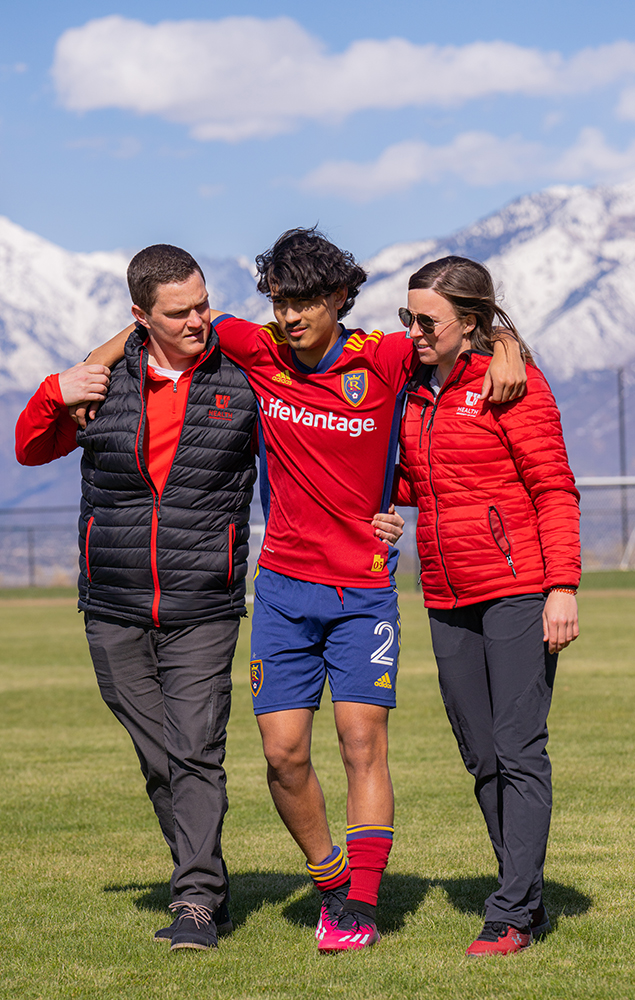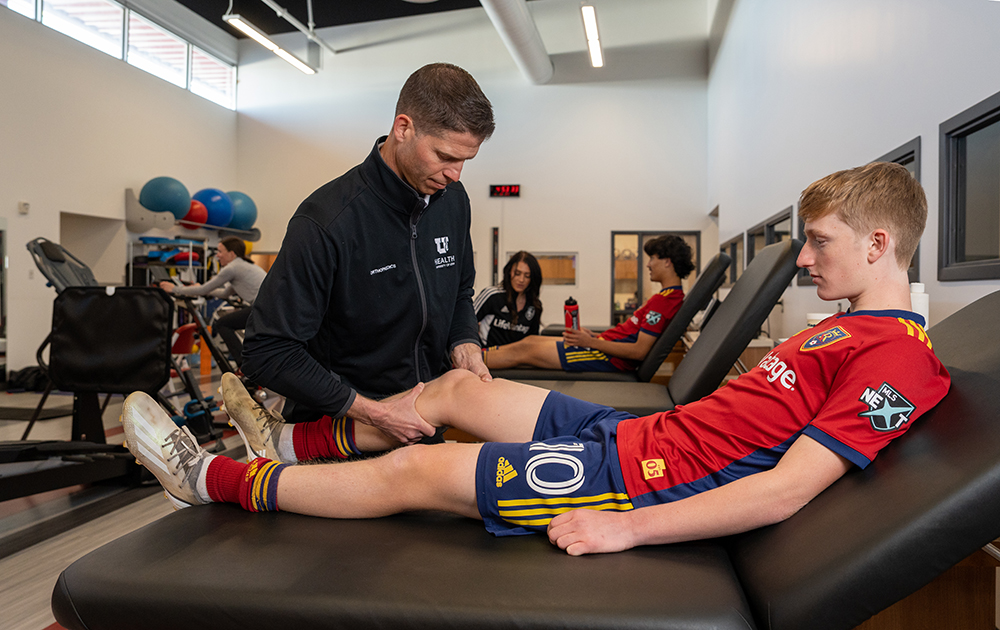Treating Common Youth Sports Injuries


The bones, muscles, ligaments, and tendons in your child's body are different from those of an adult, so when your child experiences common sports injuries, it's important to get the right care from a doctor who specializes in sports medicine or pediatric orthopedics.
If your child gets hurt during a game and needs immediate attention, our Injury Clinic at the University Orthopaedic Center offers same-day, walk-in appointments in the afternoons and evenings. Our Injury Clinic provides convenient care and short wait times unlike an emergency room visit.
The most common sports injuries that children and teens experience from sports and other physical activity include:
Sprain vs. Strain
Sprains are injuries to the ligaments (the tissues connecting bones in the joint area, such as an ankle, knee, or shoulder) and strains are injuries to the muscles or tendons that connect muscle to bone. These types of injuries are caused by the ligaments, muscles, or tendons getting stretched or torn, and is one of the most common high school sports injuries.
However, sprains and strains can occur at any age. These are often the result of a hard fall, forceful hits, or twisting or landing on part of the body in an awkward position. In some cases, strains can be caused by overusing or stressing a muscle or tendon. Strains could become chronic if you continue to stress the same muscles or tendons over time.
Sprain & Strain Symptoms
Most sprains and strains are acute injuries with symptoms that include:
- sudden pain,
- swelling or bruising,
- muscle spasms (strains),
- cramping (strains),
- difficulty moving, or
- inability to use the joint, muscle, or tendon that was injured.
One of our specialists will perform a physical examination to diagnose a sprained ligament or strained muscle or tendon. In some cases, we may recommend X-rays to rule out a fracture or broken bone.
Strain and Sprain Treatment
For most sprains and strains, we recommend RICE:
- Rest — Rest the injured area. For lower-body injuries your child may need crutches, a wheelchair, or other walking assistance.
- Ice — Place ice on the area as soon as possible after the injury occurs to reduce inflammation and swelling. Leave the ice on the injury for 20 minutes, and repeat four to eight times daily.
- Compression — Place bandages or other compression devices around the area. If necessary, a doctor will give you specialized casts, boots, or splints to keep it stable while it heals.
- Elevation — Keep the injured limb elevated to improve blood flow.
We may also recommend taking non-steroidal anti-inflammatory drugs (NSAIDs) for pain relief. During this time, your child should not participate in any sports or other activities that could cause further harm or injury to the area. As the injury begins to heal, he or she can begin some gentle range-of-motion exercises to keep the muscles, ligaments, and tendons from getting stiff. Talk to your child’s doctor about how much to do and how soon.
Once we give your child clearance, he or she can work on strengthening exercises to prepare for his or her return to full activity. For serious conditions or chronic injuries, your doctor may also recommend physical therapy or other preventive exercises to strengthen the area and avoid future strains and sprains. If your child plans to return to sports, we may also recommend a brace or other device to stabilize the area.
Find a Sports Medicine Doctor Near Me
Bruises
Bumps and bruises are a natural part of childhood, and often occur when a child or teen lands in an awkward position, runs into things, or falls during sports or other play.
Bruising Symptoms
Most people are familiar with the signs of bruising such as tenderness and discoloration from blood vessel damage. Eventually it will turn a dark purple or black and blue, then lighten to a green or yellow as it heals. In some cases, the initial injury may cause a painful, raised hematoma, or clotted blood under the skin (often called a “goose egg”). Another type of bruising that children may experience during sports is a bone bruise (damage to the tissues in the bones). The signs and symptoms of a bone bruise are similar to other bruises, but they often last longer and may be more painful than skin bruises.
Bruise Treatment
Bruises are often treated right at home. We recommend the following treatments:
- Ice the bruise to reduce swelling.
- Elevate the injured body part to avoid blood pooling, which could increase the size of the bruise.
- Cover the bruise to avoid injuring the same area more.
Types of Bruises to Worry About


You should visit the Injury Clinic or see your child’s doctor if your child’s bruise:
- continues to grow after 24 hours,
- lasts longer than a couple of weeks,
- goes away and comes back for no reason (no additional injury),
- may be related to a broken bone or fracture,
- causes severe swelling or tightness in the area,
- makes it difficult to see (for bruises in the eye area), or
- is on your child’s head, trunk, or stomach.
Bone Fractures
Children who participate in sports are often at a higher risk of broken bones and fractures. Since a child’s bones are still in the process of growing, fractures require specialized care, particularly if there is growth plate damage.
Fracture Symptoms
The most common signs of a broken bone include:
- pain and swelling in the injured area,
- tenderness and bruising,
- visibly crooked or deformed body parts, or
- skin tears or damage at the site of the injury.
If you suspect your child may have a broken bone, visit our Injury Clinic immediately. We will examine the area and may order additional testing to identify the extent of the injury, such as an X-ray, or, for more severe injuries, MRI (magnetic resonance imaging) or CT scans (computed tomography).
Fracture Treatment: Closed Reduction
Most fractures can be treated without surgery. The closed reduction procedure allows us to put the broken bone pieces back together so they can heal properly into a single bone. We will either give you a sedative or anesthesia to block the pain. Once the pain medicine sets in, we push or pull the bone to set it into the correct position. We will use a cast or other device to immobilize the area for a period of time during the healing process. The exact length of time that a cast is required depends on which bone(s) were broken and the extent of the injury.
Instances that may require orthopedic surgery include:
- broken bones or fractures where there are multiple breaks or
- the doctor is unable to reset the pieces of the bone externally.
Dislocations
Dislocation injuries are the result of extreme force on a ligament, causing two connecting bones to separate. Dislocations can occur in any place where a ligament connects two bones including:
- knees,
- ankles,
- fingers,
- elbows, and
- hips.
These types of dislocations are less common in children and teens because the muscles and tendons surrounding the bones are stronger than the growth plates, so extreme force generally results in a fracture rather than a dislocation.
However, a dislocated shoulder is the exception — an injury that is common in both children and teens who play sports. The shoulder, with its extensive range of motion, is at a higher risk for dislocation under extreme force, such as a hard fall or collision.
A sports medicine physician or pediatric orthopedist will perform a physical examination to diagnose a shoulder or other joint dislocation. Some of the symptoms of dislocation can mirror other injuries, so it’s important to have your child checked by a pediatric orthopedic doctor, who may recommend imaging studies, including X-ray or MRI as necessary to identify the extent of the injury.
Dislocation Symptoms
The symptoms of a dislocation injury include:
- pain in the area of the dislocation,
- swelling or bruising,
- obvious deformity at the joint, and
- numbness, weakness, and difficulty moving the injured area.
Dislocation Treatment
The age and overall health of your child, including the extent of his or her injury, will determine the treatment we choose. Our treatment approaches typically include:
- Setting the dislocated joint back in place without surgery (under sedation, to help your child relax and avoid pain). We may immobilize the area with a splint or cast to avoid further injury while it heals.
- Orthopedic surgery for a recurring dislocation or significant damage to the muscles, tendons, or ligaments.
- Prescribing NSAIDs (nonsteroidal anti-inflammatory drugs or other pain relievers to relieve any discomfort or pain.
- Restricting activity while it heals.
- Physical therapy to stretch and strengthen the area, if necessary.
Tendonitis
Inflammation in the tendons, or the fibrous connective tissue between muscles and bones, is called tendonitis. For most children and teens, tendonitis develops as a result of overuse or repeated injury without sufficient healing time in between. It can begin with an acute injury or repetitive activities, which could result in pain during sports or daily activities. It can also weaken the tendon over time so it’s more susceptible to a rupture or tear. This injury is most common in the Achilles and patellar tendons (for running and jumping sports), the shoulder (for overhead sports) or elbow (for tennis players).
Tendonitis Symptoms
Some signs of tendonitis can include:
- pain in the tendon area,
- pain with movement of the muscles attached to the joint,
- pain that increases over time with continual activity,
- swelling, stiffness, or weakness in the joint area, and
- popping or grinding at the joint.
These symptoms mirror many other conditions, so it’s important to see a doctor who specializes in children’s sports medicine or pediatric orthopedics for a correct diagnosis.
A doctor will generally diagnose tendonitis based on the symptoms described above and a physical examination. Imaging studies such as ultrasound or MRI may be used when the doctor believes there could be other injuries.
Tendonitis Treatment
Initial treatment for tendonitis in children includes RICE (rest, ice, compression, elevation) and anti-inflammatory pain medication. During this time, it’s important that your child modifies his or her activities to avoid further injury. Your child’s doctor may recommend physical therapy, stretching, or other measures to strengthen the area and prevent recurring injury.
Visit Our Injury Clinic
Children’s sports injuries and treatments differ from those of adults and should be treated by a sports medicine or pediatric orthopedic doctor. If your child has a sports-related injury, call 801-587-7109 to schedule an appointment at our Orthopaedic Injury Clinic.










